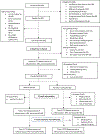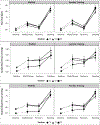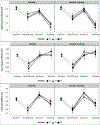The Impact of Aerobic Training on Cardiovascular Reactivity to and Recovery From Psychological and Orthostatic Challenge
- PMID: 33337592
- PMCID: PMC7858227
- DOI: 10.1097/PSY.0000000000000896
The Impact of Aerobic Training on Cardiovascular Reactivity to and Recovery From Psychological and Orthostatic Challenge
Abstract
Objective: Elevated cardiovascular reactivity to, and reduced recovery from, challenging events may increase the risk of cardiovascular disease, and exercise training may reduce this reactivity. However, in a randomized controlled trial of aerobic versus strength training in sedentary, healthy young adults, we found no training group differences in reactivity or recovery. Because strength training also may have a reactivity-reducing effect, we conducted a secondary analysis of data from another trial, this time with a wait-list control condition.
Methods: One hundred nineteen healthy, young, sedentary adults were randomized to a 12-week aerobic training program or wait-list control. Before (T1) and after (T2) training and after 4 weeks of sedentary deconditioning (T3), we measured heart rate (HR), heart rate variability, and blood pressure at rest and in response to and recovery from psychological and orthostatic challenge. Data were analyzed using a group (aerobic versus wait-list) by session (T1, T2, and deconditioning) and by period (baseline, psychological challenge, recovery, standing) three-way analysis of variance with prespecified contrasts.
Results: Aerobic capacity significantly increased at T2 and decreased at T3 only in the aerobic training group. The groups did not differ on HR, heart rate variability, or blood pressure reactivity to or recovery from challenge. Without baseline adjustment, there were no significant treatment differences in response to challenges. With baseline adjustment, there were significant treatment by session effects for HR (Cohen d = 0.54, p = .002), systolic blood pressure (d = 0.44, p = .014), diastolic blood pressure (d = 0.74, p = .002), and root mean squared successive difference (d = 0.48, p = .006) reactivity from T1 to T2 only for orthostatic challenge: at T2, reactivity in the aerobic group was nonsignificantly reduced, compared with T1. In the wait-list group, reactivity significantly increased after T1.
Conclusions: This study raises further doubt about attenuation of cardiovascular reactivity or enhancement of recovery as a cardioprotective mechanism of aerobic exercise training.Clinical Trial Registration:ClinicalTrials.gov Unique identifier: NCT01335737.
Copyright © 2020 by the American Psychosomatic Society.
Conflict of interest statement
Conflicts of Interest
None
Figures



Similar articles
-
Impact of aerobic training on cardiovascular reactivity to and recovery from challenge.Psychosom Med. 2011 Feb-Mar;73(2):134-41. doi: 10.1097/PSY.0b013e31820a1174. Epub 2011 Jan 21. Psychosom Med. 2011. PMID: 21257979 Free PMC article. Clinical Trial.
-
Aerobic exercise and strength training effects on cardiovascular sympathetic function in healthy adults: a randomized controlled trial.Psychosom Med. 2013 May;75(4):375-81. doi: 10.1097/PSY.0b013e3182906810. Epub 2013 Apr 29. Psychosom Med. 2013. PMID: 23630307 Free PMC article. Clinical Trial.
-
Effects of aerobic conditioning on cardiovascular sympathetic response to and recovery from challenge.Psychophysiology. 2013 Oct;50(10):963-73. doi: 10.1111/psyp.12078. Epub 2013 Jul 28. Psychophysiology. 2013. PMID: 23889039 Free PMC article. Clinical Trial.
-
Can Acute Exercise Lower Cardiovascular Stress Reactivity? Findings from a Scoping Review.J Cardiovasc Dev Dis. 2022 Mar 31;9(4):106. doi: 10.3390/jcdd9040106. J Cardiovasc Dev Dis. 2022. PMID: 35448082 Free PMC article.
-
Exercise as a tool for hypertension and resistant hypertension management: current insights.Integr Blood Press Control. 2018 Sep 20;11:65-71. doi: 10.2147/IBPC.S136028. eCollection 2018. Integr Blood Press Control. 2018. PMID: 30288097 Free PMC article. Review.
Cited by
-
Effects of exercise modalities on physical function and quality of life in patients with heart failure: A systematic review and network meta-analysis.ESC Heart Fail. 2025 Aug;12(4):2427-2440. doi: 10.1002/ehf2.15256. Epub 2025 Feb 28. ESC Heart Fail. 2025. PMID: 40017307 Free PMC article.
-
Effect of Exercise Modality on Heart Rate Variability in Adults: A Systematic Review and Network Meta-Analysis.Rev Cardiovasc Med. 2024 Jan 9;25(1):9. doi: 10.31083/j.rcm2501009. eCollection 2024 Jan. Rev Cardiovasc Med. 2024. PMID: 39077654 Free PMC article.
-
Exercise training improves blood pressure reactivity to stress: a systematic review and meta-analysis.Sci Rep. 2023 Jul 6;13(1):10962. doi: 10.1038/s41598-023-38041-9. Sci Rep. 2023. PMID: 37414810 Free PMC article.
-
Does Exercise Training Improve Cardiac-Parasympathetic Nervous System Activity in Sedentary People? A Systematic Review with Meta-Analysis.Int J Environ Res Public Health. 2022 Oct 26;19(21):13899. doi: 10.3390/ijerph192113899. Int J Environ Res Public Health. 2022. PMID: 36360777 Free PMC article.
References
-
- Matthews KA, Zhu S, Tucker DC, Whooley MA. Blood Pressure Reactivity to Psychological Stress and Coronary Calcification in the Coronary Artery Risk Development in Young Adults Study. Hypertension. 2006;47:391–5. - PubMed
-
- Jennings JR, Kamarck TW, Everson-Rose SA, Kaplan GA, Manuck SB, Salonen JT. Exaggerated Blood Pressure Responses During Mental Stress Are Prospectively Related to Enhanced Carotid Atherosclerosis in Middle-Aged Finnish Men. Circulation. 2004;110:2198–203. - PubMed
-
- Treiber FA, Kamarck T, Schneiderman N, Sheffield D, Kapuku G, Taylor T. Cardiovascular reactivity and development of preclinical and clinical disease states. Psychosom Med 2003;65:46–62. - PubMed
-
- Chida Y, Steptoe A. Greater Cardiovascular Responses to Laboratory Mental Stress Are Associated With Poor Subsequent Cardiovascular Risk Status: A Meta-Analysis of Prospective Evidence. Hypertension. 2010;55:1026–32. - PubMed
-
- Phillips AC, Ginty AT, Hughes BM. The other side of the coin: blunted cardiovascular and cortisol reactivity are associated with negative health outcomes. Int J Psychophysiol 2013;90:1–7. - PubMed

